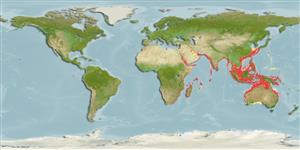Environment: milieu / climate zone / depth range / distribution range
Ecologie
marien; brak water rifbewoner; oceanodroom (Ref. 51243); diepte 20 - 200 m (Ref. 36128). Subtropical; 32°N - 35°S, 18°E - 157°E
Indo-West Pacific: Red Sea and East Africa to the Philippines, north to southern Japan and Korea, south to northern Australia. Introduced into the eastern Mediterranean Sea.
Lengte bij maturiteit / Grootte / Gewicht / Leeftijd
Maturity: Lm 45.7 range ? - ? cm
Max length : 100.0 cm TL mannelijk / geslacht onbekend; (Ref. 7050); common length : 60.0 cm TL mannelijk / geslacht onbekend; (Ref. 3476); max. gepubliceerd gewicht: 3.5 kg (Ref. 40637)
Dorsale stekels (totaal) : 9 - 10; Dorsale zachte stralen (totaal) : 13; Anale stekels: 0; Anale zachte stralen: 13. Brownish or grayish above, whitish below; caudal fin 2-3 horizontal black stripes (Ref. 4315). Head strongly depressed. Preopercular spines 2, lower usually longest. Vomerine teeth in a single transverse band. Dorsal fin I,VII,I, I,I,VII,I or I,VIII, 13. Anteriormost lateral line scale usually with a small spine or ridge. Diagonal scale rows slanting backward above lateral line 83-107. Iris lappet a single elongated lobe. Identified by the distinctive color pattern on the caudal fin: centrally yellow and black stripes on upper and lower margins (Ref. 48635).
Found on sandy and muddy bottoms of coastal waters (Ref. 5213, 48635). Frequently in estuaries, juveniles have been taken in freshwater. Taken by handlining and seining in shallow waters and by trawling at depths to 30 m, usually less (Ref. 9790). A good food fish (Ref. 4315) that is marketed fresh (Ref. 5284). Commercially cultured in Japan. Used in Chinese medicine (Ref. 12166).
Also Ref. 103751.
Bauchot, M.-L., 1987. Poissons osseux. p. 891-1421. In W. Fischer, M.L. Bauchot and M. Schneider (eds.) Fiches FAO d'identification pour les besoins de la pêche. (rev. 1). Méditerranée et mer Noire. Zone de pêche 37. Vol. II. Commission des Communautés Européennes and FAO, Rome. (Ref. 3397)
Status op de Rode Lijst van het IUCN (Ref. 130435: Version 2024-1)
Gevaar voor de mens
Harmless
Gebruik door de mens
Visserij: commercieel; Aquacultuur: commercieel; sportvis: ja
Tools
Speciale rapporten
Download XML
Internetbronnen
Estimates based on models
Preferred temperature (Ref.
123201): 21.7 - 28.3, mean 26.5 °C (based on 979 cells).
Fylogenetische diversiteitsindex (Ref.
82804): PD
50 = 0.5000 [Uniqueness, from 0.5 = low to 2.0 = high].
Bayesian length-weight: a=0.00447 (0.00363 - 0.00550), b=3.09 (3.03 - 3.15), in cm total length, based on LWR estimates for this species (Ref.
93245).
Trofisch niveau (Ref.
69278): 3.6 ±0.6 se; based on diet studies.
Weerstandsvermogen (Ref.
120179): Gemiddeld, minimale populatieverdubbelingstijd 1,4-4,4 jaar (tmax=7).
Prior r = 0.64, 95% CL = 0.42 - 0.96, Based on 1 data-limited stock assessment.
Fishing Vulnerability (Ref.
59153): Moderate vulnerability (37 of 100).
Climate Vulnerability (Ref.
125649): Very high vulnerability (79 of 100).
Nutrients (Ref.
124155): Calcium = 43.2 [3.4, 132.2] mg/100g; Iron = 1.21 [0.32, 3.24] mg/100g; Protein = 18.8 [16.5, 21.1] %; Omega3 = 0.211 [0.090, 0.614] g/100g; Selenium = 48.1 [16.2, 149.5] μg/100g; VitaminA = 28.9 [8.7, 99.7] μg/100g; Zinc = 0.763 [0.357, 1.425] mg/100g (wet weight); based on
nutrient studies.
